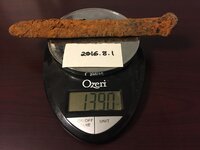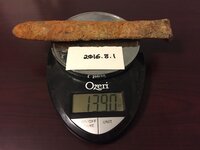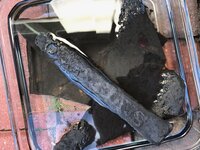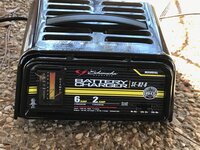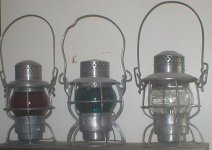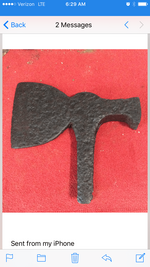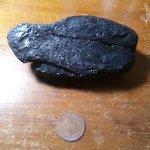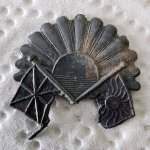usatc
Jr. Member
Hi thanks for looking and hope I can figure out what I'm doing wrong.
Recently I've been destroying my rusted artifacts. For example I had this item railroad wedge item. Quite heavy and crusty but solid. The first 12 hour soak yielded fantastic results and lettering (Avery & co) was becoming clearly visible and 80%ish of rust was gone (sorry no pics as checked in evening, turned lights on checked then put back in).
The next morning I was excited to see it and found a black sludgy mess. Think of it as an onion - it had lost 60% ish of all iron and almost all the words on the artifact sloughed off in chunks (the iron was coming off in layers like an onion). I did not misconnect the + and -. The liquid vaguely like tar. Nothing in the bath touched. I'm connecting my negative clip to a piece of the iron to be cleaned above electro line. The positive was connected to a sheet of graphite.
I was using a two gallon bucket and graphite / washing soda. I thought maybe the first pieces touched so now use a one gallon rectangular plastic tub. However I'm concerned as I have destroyed another piece of rusted junk test iron yesterday somehow. Same thing, rust came off but also chunks of iron. You can see the triangular crusted shape prior. Taking it out 24 hours later water was black and rust and iron coming off, like chips of an arrowhead. I personally brushed a piece of black flint like iron chipping (no rust, just iron) a straight edge. And I've done electrolysis when I started a few weeks ago on two similar broken farm implements - one came out beautifully the other not so much - but that was putting I could tell was already there.
Any help would be appreciated as I have a lot of iron artifacts I planned on cleaning but losing faith in my ability to do electroalysis. For this piece the first two settings didn't make any bubbles so I cranked it to 6v 12a. Could that high on a crusty item have caused the bubble reaction to damage it vs a lower setting to remove rust?
Thank you!
Recently I've been destroying my rusted artifacts. For example I had this item railroad wedge item. Quite heavy and crusty but solid. The first 12 hour soak yielded fantastic results and lettering (Avery & co) was becoming clearly visible and 80%ish of rust was gone (sorry no pics as checked in evening, turned lights on checked then put back in).
The next morning I was excited to see it and found a black sludgy mess. Think of it as an onion - it had lost 60% ish of all iron and almost all the words on the artifact sloughed off in chunks (the iron was coming off in layers like an onion). I did not misconnect the + and -. The liquid vaguely like tar. Nothing in the bath touched. I'm connecting my negative clip to a piece of the iron to be cleaned above electro line. The positive was connected to a sheet of graphite.
I was using a two gallon bucket and graphite / washing soda. I thought maybe the first pieces touched so now use a one gallon rectangular plastic tub. However I'm concerned as I have destroyed another piece of rusted junk test iron yesterday somehow. Same thing, rust came off but also chunks of iron. You can see the triangular crusted shape prior. Taking it out 24 hours later water was black and rust and iron coming off, like chips of an arrowhead. I personally brushed a piece of black flint like iron chipping (no rust, just iron) a straight edge. And I've done electrolysis when I started a few weeks ago on two similar broken farm implements - one came out beautifully the other not so much - but that was putting I could tell was already there.
Any help would be appreciated as I have a lot of iron artifacts I planned on cleaning but losing faith in my ability to do electroalysis. For this piece the first two settings didn't make any bubbles so I cranked it to 6v 12a. Could that high on a crusty item have caused the bubble reaction to damage it vs a lower setting to remove rust?
Thank you!


